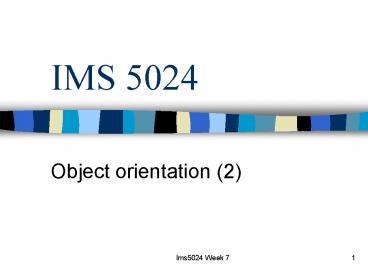IMS 5024 PowerPoint PPT Presentation
1 / 21
Title: IMS 5024
1
IMS 5024
- Object orientation (2)
2
Content
- Group assignment
- Use-cases
- State transition diagrams
- Place in ISD
- Evaluation of Object orientation
- Reading list
3
Group assignment
- Individual accountability
- Pitfalls
- Not starting early enough
- Not reporting problems in the group early
4
Techniques used in Object orientation
- Object model object diagrams
- Dynamic model state transition diagrams
- Functional model action data flow diagrams, use
case - ADD
- System definition - Rich pictures
- Actor table or use case diagrams
- Sequence diagrams
5
Difference in view?
- Emphasis on use-case as basis of all further
activities - Requirements
- Analysis?
- Design?
- Iteration!!
- Increments!!
6
What is a use case?
- a particular form or pattern or exemplar of
usage, a scenario that begins with some user of
the system initiating some transaction or
sequence of interrelated events. (Jacobson, 1992) - Or
- A use case is a sequence of actions that the
system performs to offer some results of value to
an actor - Or
- A pattern for interaction between the system and
actors in the application domain (Mathiassen et
al., 2000)
7
What is an actor?
- A type of user
- An abstraction of users or other systems that
interact with the target system (Mathiassen et
al., 2000). - Also roles of actors
8
Example of an actor
- System interact with a type of user that will use
the system to order goods, pay invoices, receive
goods ect. Can call this a buyer
Buyer
9
Use case
- Represented in the use case diagram as an elipse
- A use case has operations and attributes
- A use case description can include state chart
diagrams, activity diagrams, collaboration ans
sequence diagrams
Withdraw money
10
Use case diagram for Billing and payment system
Order goods
Invoice buyer
Pay invoice
11
Example of an use case description for Pay invoice
- Brief description
- The use case Pay Invoice is used by a buyer to
schedule invoice payments. The Pay Invoice use
case then effects the payment on the due date. - Initial step-by-step description
- Before this use case can be initiated, the Buyer
has already received an invoice (delivered by
another use case called Invoice Buyer) and has
also received the good or services ordered - The buyer studies the invoice to pay and checks
that it is consistent with the original order - The Buyer schedules the invoice for payment by
the bank. - On the day payment is due, the system checks to
see if there is enough money in the buyers
account. If enough money is available, the
transaction is made
12
State transition diagrams
- Defines allowable changes for data objects.
- State is a set of values an object can have.
- Transition event causing a change to the set of
values
13
Icons used in state transition diagrams
- Label line with event and process
Class/object states
Transition
14
Step in drawing a diagram
- Draw one diagram for each object/class
- Identify the possible states the class/object can
take - Draw circles on a diagram labeling each with a
state - Connect the states show transition from one state
to another - Label transition lines to identify the events
- Label the lines with the process that manage the
the event
15
Example of a state transition diagram
Null
Pending
- Received
Order object
Receive supplies
Accept shipment
Return to supplier
Accepted
16
Thinking in Object orientation
- Hard Vs Soft ??
- Perspective
- Objective vs Subjective
- Nature of the organisation
17
Evaluation of Object oriented modelling
Problem oriented Product oriented
Concep-tual Structured analysis Entity relationship modelling Logical construction of systems Modern structured analysis Object oriented analysis Structured design Object oriented design
Formal PSL/PSA JSD VDM Levels of abstraction Stepwise refinement Proof of correctness Data abstraction JSP Object oriented programming
18
Advantages/ Benefits of object orientation
- It unifies many aspects of the information
systems development process. - It facilitates re-use of software code make
application development quicker and more robust - Ability to tackle more complex problems
- Improve user/analyst relations ???
- Improvement in the consistency of results
- Represent factors for change in the model
19
Disadvantages of object orientation
- Only now starting to be used
- Case tools are not readily available
- Not easily understood by novice users
- Difficult to master for some analysts designers
programmers - Inefficiency (need a lot of power)
- Others??
20
Object orientation view of ISD
Objectives
Development group
Object system
Object system
Change process
Environment
Hirschheim et al see reading list
21
Reading for next week
- Checkland, P., Scholes, J. (1990). Soft Systems
Methodology in Action. John Wiley Sons Ltd,
Great Britian, 1990. Chapter 1 and 2

